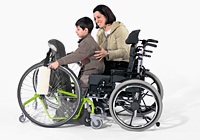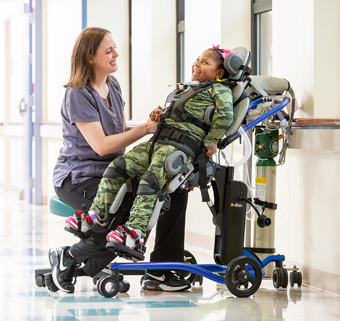Motor Learning & Practice
| June 2012 Today’s post is the first in a series of articles on motor learning and practice. You’ll notice that I make frequent reference to the MOVE Curriculum. For those unfamiliar with this, MOVE is an activity-based program designed to teach children with severe disabilities the functional motor skills needed to sit, stand, and walk as independently as possible. There’s a great video introduction to the MOVE Program as implemented in a school in Michigan available on Youtube. There are many parallels between MOVE and the implications of motor control and motor learning research.
Today’s post is the first in a series of articles on motor learning and practice. You’ll notice that I make frequent reference to the MOVE Curriculum. For those unfamiliar with this, MOVE is an activity-based program designed to teach children with severe disabilities the functional motor skills needed to sit, stand, and walk as independently as possible. There’s a great video introduction to the MOVE Program as implemented in a school in Michigan available on Youtube. There are many parallels between MOVE and the implications of motor control and motor learning research.
Also by way of introduction, readers will want to take time to review these three important assumptions of motor learning before reading further.
Motor Learning & Practice – Part II
Motor Learning & Practice – Part III
The field of motor learning has tremendous implications for pediatric therapy. Since one of the primary aims of therapy is the acquisition of the functional motor skills, the study of motor learning should help to guide our interventions. The MOVE curriculum is directly concerned with learning motor skills through specific training and practice.
The term motor learning can be described as “the acquisition of new skills with practice.” (Schmidt, 1991, p.49) Note that this definition includes several important characteristics. First, the “acquisition” of skills reflects a relatively permanent change, rather than a transitory change in behavior. Second, “skills” are being acquired, as opposed to movement patterns isolated from their functional significance. Lastly, note the inclusion of the word “practice.” Motor learning describes skills that are learned through practice; these skills do not emerge because of other factors such as neural maturation, passively imposed movements, or the integration of primitive reflexes. A more detailed definition of motor learning, also from Schmidt is, “a set of processes associated with practice or experience leading to relatively permanent changes in the capability for movement.” (Schmidt, 1999, p. 264) This definition emphasizes that the changes occurring with motor learning are relatively permanent, and that they involve the internal “capability” for movement rather than the directly observable performance.
Among children with severe disabilities, simple functional motor abilities that most of us take for granted are often lacking. In typically developing children these motor skills emerge without specific training, although many of these skills may indeed be learned through practice. Motor learning is a powerful tool with which we can help children with severe disabilities gain functional motor skills.
PRACTICE
Practice is the active process of attempting to perform a task, and it leads to the acquisition of skill. In order to be effective, practice trials usually need to be repeated many times. We will discuss the nature of repetition in more depth later on, but it is important to note that the process of problem-solving needs to be repeated for effective learning, rather than simply the repetition of a movement. There are many practice variables that affect learning, such as the amount of practice, practice scheduling, and variations in the task and context of practice.
Amount of Practice
Probably the most important question we will discuss in this chapter is, “How much practice is needed to learn a movement skill?” Children with severe disabilities lack many functional motor skills. I suggest that many of these children would benefit from more opportunities to practice their motor skills. Factors affecting motor learning in this population include the inability to practice many motor skills without assistance or physical support, and slower rates of learning. Common sense would suggest that increased practice of a task would enhance learning and skill acquisition in that task. The experts on motor learning agree, as shown in the following quotations:
One practice variable dwarfs all the others in terms of importance, and it is so obvious that it need hardly be mentioned at all – practice. Clearly, more learning will occur if there are more practice trials, all other things being equal. Perhaps we do not need to say any more about the amount of practice than this: in structuring the practice session, the number of practice attempts should be maximized. (Schmidt & Lee, 1999, p. 286)
It is probable that some of the failure of rehabilitation is due to too little time actually being spent in practicing motor tasks using guidelines provided by the therapist. (Carr & Shepherd, 1987, p. 52)
Typically, the more practice you can give a patient, the more the patient learns, with other things being equl. (Shumway-Cook & Woollacott, 1995, p. 35)
Practice is essential for motor learning and the development of motor programs. In general, increased practice leads to increased learning. (O’Sullivan, 1994, p. 239)
Learning is directly determined by the amount of practice. (Gentile, 2000, p. 173)
In short, the most powerful way we can enhance skill acquisition would appear to be increasing the amount of practice. All of the other variables that we discuss in later posts such as practice scheduling, feedback, modeling, etc., although they can be manipulated to benefit learning, are not as important as this one factor. No one disputes that practice has a positive effect on learning, or that more practice results in more learning. However, these principles of motor learning are not yet being adequately applied with our populations. One of the biggest benefits of the MOVE curriculum is that it gives a structured way for practice of mobility tasks to be incorporated consistently throughout the day. (Bidabe, 1999)
Material for this three-part series is excerpted from the book Children with Severe Disabilities and the MOVE Curriculum: Foundations of a Task-Oriented Therapy Approach by Gilbert Thomson, PT, published in 2005. To obtain a copy of the book contact MOVE International.
Motor Learning & Practice – Part II
Motor Learning & Practice – Part III
References
Bidabe, DL. MOVE: Mobility Opportunities Via Education. Bakersfield, CA: Kern County Superintendent of Schools; 1999.
Carr JH, Shepherd RB. A Motor Learning Model for Rehabilitation. In: Carr JH, Shepherd RB, eds. Movement Science: Foundations for Physical Therapy in Rehabilitation. Rockville, MD: Aspen Publishers; 1987:31-91.
Gentile AM. Skill Acquisition: action, movement and neuromotor processes. In : Carr JH, Shepherd RB, eds.Movement Science: Foundations for Physical Therapy in Rehabilitation. 2nd ed. Rockville, MD: Aspen Publishers; 2000:111-187.
O’Sullivan SB. Strategies to improve motor control and motor learning. In: O’Sullivan SB, Schmitz TJ, eds.Physical Rehabilitation: Assessment and Treatment, 3rd ed. Philadelphia, PA: FA Davis; 1997:225-249.
Schmidt RA, Lee TD. Motor Control and Learning: A Behavioral Emphasis. 3rd ed. Champaign, IL: Human Kinetics; 1999.
Schmidt RA. Motor learning principles for physical therapy. In: Foundations for Physical Therapy.Contemporary Management of Motor Control Problems, Proceedings of the II STEP Conference. Alexandria; VA: Foundations for Physical Therapy; 1991:49-63.
Shumway-Cook A, Woollacott M. Motor Control: Theory and Practical Applications. Philadelphia, PA Lippincott Williams & Wilkins; 1995.






